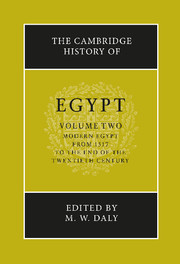Book contents
- Frontmatter
- 1 Ottoman Egypt, 1525–1609
- 2 Egypt in the seventeenth century
- 3 Egypt in the eighteenth century
- 4 Culture in Ottoman Egypt
- 5 The French occupation of Egypt, 1798–1801
- 6 The era of Muhammad ’Ali Pasha, 1805–1848
- 7 Egypt under the successors of Muhammad ’Ali
- 8 The Egyptian empire, 1805–1885
- 9 The ‘Urabi revolution and the British conquest, 1879–1882
- 10 The British occupation, 1882–1922
- 11 Social and economic change in the “long nineteenth century”
- 12 The liberal age, 1923–1952
- 13 Egypt: society and economy, 1923–1952
- 14 Republican Egypt interpreted: revolution and beyond
- 15 Modern Egyptian culture in the Arab world
- Select Bibliography
- Index
- References
13 - Egypt: society and economy, 1923–1952
Published online by Cambridge University Press: 28 March 2008
- Frontmatter
- 1 Ottoman Egypt, 1525–1609
- 2 Egypt in the seventeenth century
- 3 Egypt in the eighteenth century
- 4 Culture in Ottoman Egypt
- 5 The French occupation of Egypt, 1798–1801
- 6 The era of Muhammad ’Ali Pasha, 1805–1848
- 7 Egypt under the successors of Muhammad ’Ali
- 8 The Egyptian empire, 1805–1885
- 9 The ‘Urabi revolution and the British conquest, 1879–1882
- 10 The British occupation, 1882–1922
- 11 Social and economic change in the “long nineteenth century”
- 12 The liberal age, 1923–1952
- 13 Egypt: society and economy, 1923–1952
- 14 Republican Egypt interpreted: revolution and beyond
- 15 Modern Egyptian culture in the Arab world
- Select Bibliography
- Index
- References
Summary
The constitution of 1923 consolidated a new legal and institutional framework for the Egyptian state. Yet this political moment is an inadequate marker of the economic and social developments inextricably bound up with it. Changes in a society and its political economy are best analyzed in terms of long-term historical and structural tendencies that cannot be dated with precision.
The years between the accession of Khedive ’Abbas Hilmi (r. 1892–1914) and the election of the first Wafd government in 1924 in many ways delimit a single era. This conjuncture was formed by stabilization and subsequent frustration of British colonial rule; increased capital investment in agriculture, transport, commerce, and industry; and dramatic expansion, followed by sharp decline, in agricultural productivity. From this perspective, the popular reaction to the Dinshawai incident of June 1906 was not a spontaneous originary moment of nationalist mobilization, but a response to the developments that preceded it and informed its meaning. A reconfigured market; a reactivated political movement featuring a mélange of Egyptianist, Ottomanist, and Islamist discourses; new social groups; revised ideals of gender relations; and new forms of culture and politics elaborated and legitimized one another. After the First World War, the moral, economic, and political crisis of Anglo-French colonialism created an environment conducive to a new political order in Egypt.
The nationalist movement was an effect of urban middle strata educated in modern, western-style, schools – the effendiyya – and circles of large landholders simultaneously articulating and responding to collective anti-colonialist sentiment and action. This dynamic process reorganized the structural and discursive limits governing nearly every major question in Egypt until well after the military coup of July 23, 1952.
- Type
- Chapter
- Information
- The Cambridge History of Egypt , pp. 309 - 333Publisher: Cambridge University PressPrint publication year: 1998
References
- 6
- Cited by

